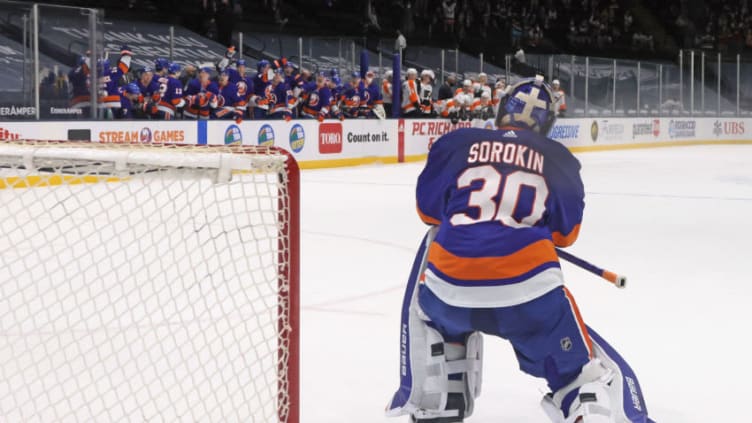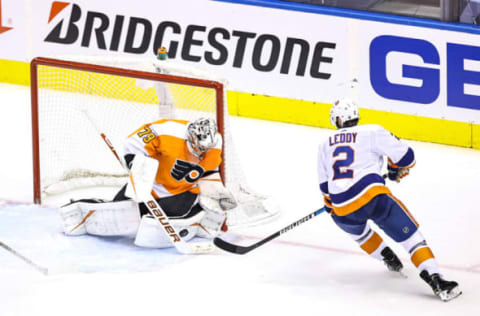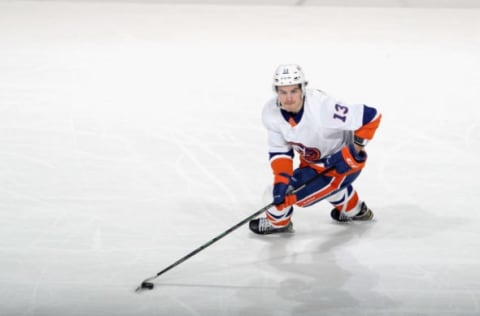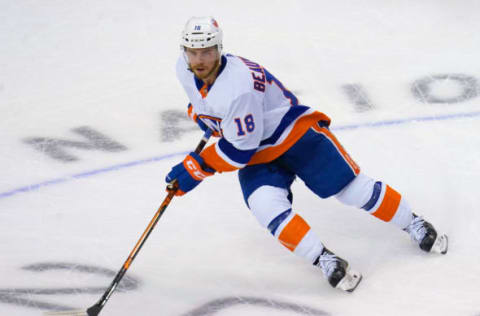Islanders: Three Takeaways from 3-2 Shootout Win over Flyers


The New York Islanders home record improved to 15-1-2 despite what was a less than optimal performance on Saturday night.
The New York Islanders found a way to snag two points on Saturday night, and that’s as important as it’s ever been despite a sub-par performance.
Here are three takeaways from the Islanders latest 3-2 win over the Philadelphia Flyers.
1. Islanders Didn’t Make Carter Hart’s Job Tough Enough
As of Sunday morning, Carter Hart’s -18.36 Goals Saved Above Expected (GSAx) stat beats out goalies like Ottawa’s Matt Murray, Nashville’s Pekka Rinne, and Detroit’s Thomas Greiss for the league’s worst mark in that category.
I’m using Top Down Hockey’s Expected Goals model, so the numbers I used will be slightly different than Moneypuck’s, but here is a link to an interactive list of the league’s worst (and best) goalies, per their GSAx, on Moneypuck.com.
It has been a very difficult season for Hart. Curiosity and rumors have swirled about why he has been so poor in 2020-21 despite an excellent first two NHL seasons. Whatever the cause of Hart’s performances may be, one thing is clear: That opponents playing him should be peppering him with shots at all times. That is something the New York Islanders did not do on Saturday.
The Islanders registered just 11 5v5 unblocked shot attempts (Fenwick For) and 10 SOG through 40 minutes of play on Saturday night. Despite scoring twice, and carrying a 2-0 lead into the third period against Philly, those shot numbers just aren’t good enough. Especially against a goalie like Hart, who has struggled more than any other NHL netminder at saving goals above expected.
Part of the problem was the Islanders just not playing with the puck enough. They were outpaced in Corsi and Fenwick at 5v5 for all three regulation periods of the game, but the 5v5 unblocked shot attempt numbers after 40 minutes were 22-11 in favor of Philadelphia.
Another issue was that the Islanders didn’t take the chance to shoot enough when they did have the puck. The Islanders game under Barry Trotz has always revolved around cycling and forechecking in the offensive zone until an opportunity from the dangerous areas opens up. The trouble with that strategy is when the cycle isn’t crisp, or the forecheck isn’t effective, those opportunities don’t always present themselves.
That was pretty much the case for the Islanders on Saturday. The passing wasn’t good enough to keep the cycle alive, the forecheckers weren’t always positioned to pressure the Flyer defense, and it led to a lot of opportunities for Philadelphia to clear their zone without facing any real danger against their goalie.
I’m not someone who yells “shoot!” at their TV very often, but I might’ve done it once or twice while watching this game. Sometimes, especially when facing a goalie struggling as badly as Hart has, it’s important to just get pucks on net. The Islanders didn’t do that enough, and it made Hart’s job a whole lot easier on Saturday night.

2. Quantity vs Quality – The Islanders Shifting Style of Play in 2020-21
The New York Islanders had to play the role of the opportunist on Saturday by scoring on the chances they had through 40 minutes. They did so, and in the end that was enough to force overtime and the shootout, where they controlled the run of play at 3v3 before a Mat Barzal shootout-winning goal.
The Islanders aren’t unfamiliar with being an opportunistic-style team that scores off of relatively few chances. Their offensive zone philosophy under Barry Trotz, as previously stated, has always revolved around creating dangerous chances off the cycle and forecheck.
That style of relying on smaller chance numbers and capitalizing on them has worked for them in the past, but it’s not really the style they’ve played in 2020-21. By that, I mean the Islanders have actually managed to become a very strong possession team in the current season, something that was missing from their 2018-19 and 2019-20 regular season runs.
The Islanders in 2020-21 boast the 12th-best 5v5 FF%, at 50.4%. Their 5v5 xGF% is 54.04, good for the 4th-best league-wide. They take home 52.48% of scoring chances, and 60.36% of high-danger chances, which ranks 7th and 1st respectively across the NHL. Those rankings all jumped at least fifteen spots from 2019-20.
#Isles 5v5 team stats in 19-20 (regular season):
— Ryan Grosso (@Ry_Gro) April 2, 2021
// 46.67% FF% (30th ranked NHL)
// 48.84% xGF% (20th ranked NHL)
// 47.91% SCF% (22nd ranked NHL)
// 50.08% HDCF% (18th ranked NHL)
So what does that mean? Well, it’s indicative of an Islanders team whose philosophy on attacking has changed. They’re not the opportunists anymore, at least not every night. No, the 2020-21 Islanders are a strong 5v5 possession-driving team who create chances off of a brutally effective forecheck and good passing and puck retrieval off the cycle.
It’s the reason why the Islanders have gained a lot more attention from the national media lately. They’re not the team who is out-performing their metrics, their success is not being deemed unsustainable anymore, and it’s because of this shifting style of play.
Mind you, if you go check the Islanders team stats from the 2020 bubble on Natural Stat Trick, you’ll find that their team-wide metrics in all these areas were already trending towards where we see them now. That’s the kind of performance the Islanders needed to prove they could carry throughout a regular season, no matter how odd that regular season may be, and so far they’ve done so.
Saturday wasn’t a great example of that style of play. As previously stated, the Islanders were out-possessed, out-shot, and out-chanced against Philly. But they found a way to win, which is most important, and they did so with 11 forwards available to them after Ross Johnston’s injury.

3. Anthony Beauvillier’s Hot Streak Continues, Wahlstrom Cools Down
Anthony Beauvillier’s season did not get off to the kind of start he would’ve liked it to, I’m sure. Beauvillier had just six points through his first 22 appearances of the 2020-21 season, and when he was healthy, he was mostly a non-factor for his team.
That isn’t the kind of performances the Islanders were hoping for from a player who is expected to be a contributor in their top-six forward group, and it wasn’t the kind of season Beauvillier was looking to have in a contract year.
But Beau’s performances have picked up in a big way since late March. He now has eight points in his last seven games since March 20, and has registered multiple shots on goal in four of those seven.
Saturday, Beauvillier had another very strong performance, scoring the Islanders two goals. He finished second among Islanders skaters with .28 ixG, behind Oliver Wahlstrom’s .7, which led all skaters from both teams in all situations.
Beauvillier and Wahlstrom have seemingly been on divergent trajectories all season. When Beauvillier was ice cold and couldn’t catch a break, Wahlstrom was shooting at an above 30% clip. Now, Beauvillier is thriving, having potted six goals in the last seven Islanders games, and shooting over 46% (!) since March 20.
Meanwhile, Wahlstrom’s red-hot production has slowed down since the 25 of March. That’s not to say Wahlly isn’t playing well, because he’s still generating shots, forechecking and back-checking well, and getting good looks from in-tight at the net. But they just aren’t going in at the same clip they once were. Which is normal.
Again, there was a stretch in which Wahlstrom was shooting around 30%. That is an unsustainable level of shooting success, no matter how good the player’s shot. What’s encouraging is that he’s still generating chances and getting his high-danger looks. Even if the chances are not going in right now, his continuing to get to those areas in the slot will mean the shots will start going in again eventually.
The Islanders season has been a bit of a revolving door of hot and cold forwards. Mathew Barzal has probably been the most consistently brilliant of the forward bunch, but players like Jordan Eberle, Brock Nelson, Wahlstrom, Beauvillier, J.G. Pageau, Josh Bailey, and Casey Cizikas have produced well at different times to keep the offense afloat as well.
Encouragingly, we haven’t seen all the Islanders forward group hit their strides in unison yet. When and if they finally do, this could be a potent offensive attack with strong possession and expected goal numbers. That’s not even factoring in the possibility of further offensive firepower being brought in before the April 12 trade deadline by Lou Lamoriello.